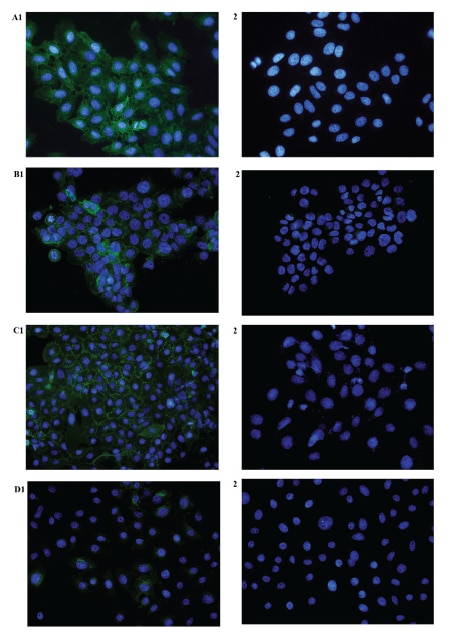Human CD47 Antibody Summary
Gln19-Pro139
Accession # Q08722
Applications
Please Note: Optimal dilutions should be determined by each laboratory for each application. General Protocols are available in the Technical Information section on our website.
Scientific Data
 View Larger
View Larger
Detection of CD47 in Human Lymphocytes by Flow Cytometry. Human peripheral blood lymphocytes were stained with Mouse Anti-Human CD47 Monoclonal Antibody (Catalog # MAB4670, filled histogram) or isotype control antibody (Catalog # MAB002, open histogram), followed by Phycoerythrin-conjugated Anti-Mouse IgG Secondary Antibody (Catalog # F0102B). View our protocol for Staining Membrane-associated Proteins.
 View Larger
View Larger
SIRP alpha /CD172a Binding to CD47-transfected HEK293 Human Cell Line is Blocked by Human CD47 Antibody. In a functional flow cytometry test, biotinylated recombinant Human SIRPa/CD172a (100 ng/mL, Catalog # 4546-SA) binds to Human CD47-transfected HEK293 human embryonic kidney cell line (black dotted line). Binding is completely blocked (orange histogram) by 2.5 µg/mL of Mouse Anti-Human CD47 Monoclonal Antibody (Catalog # MAB4670). Mouse IgG1isotype (Catalog # MAB002) at 2.5 µg/mL was used as a control (blue line). Cells were stained with Streptavidin-APC (Catalog # F0050).
Reconstitution Calculator
Preparation and Storage
- 12 months from date of receipt, -20 to -70 °C as supplied.
- 1 month, 2 to 8 °C under sterile conditions after reconstitution.
- 6 months, -20 to -70 °C under sterile conditions after reconstitution.
Background: CD47
CD47, also known as integrin-associated protein, is a ubiquitous 50 kDa multipass transmembrane protein with a single IgV-like domain at its N-terminus. CD47 binding to SIRP alpha prevents the phagocytic engulfment of viable cells. Thrombospondin interaction with CD47 on T cells reduces T cell proliferation and inflammatory reactions. Alternate splicing generates isoforms with truncated cytoplasmic domains. Within the N-terminal ECD, human CD47 shares 63% aa sequence identity with mouse and rat CD47.
Product Datasheets
Citation for Human CD47 Antibody
R&D Systems personnel manually curate a database that contains references using R&D Systems products. The data collected includes not only links to publications in PubMed, but also provides information about sample types, species, and experimental conditions.
1 Citation: Showing 1 - 1
-
CD47 as a potential prognostic marker for oral leukoplakia and oral squamous cell carcinoma
Authors: X Ye, X Wang, R Lu, J Zhang, X Chen, G Zhou
Oncol Lett, 2018-04-17;15(6):9075-9080.
Species: Human
Sample Types: Whole Cells, Whole Tissue
Applications: IHC, Inhibition
FAQs
No product specific FAQs exist for this product, however you may
View all Antibody FAQsReviews for Human CD47 Antibody
Average Rating: 5 (Based on 2 Reviews)
Have you used Human CD47 Antibody?
Submit a review and receive an Amazon gift card.
$25/€18/£15/$25CAN/¥75 Yuan/¥2500 Yen for a review with an image
$10/€7/£6/$10 CAD/¥70 Yuan/¥1110 Yen for a review without an image
Filter by:
As expected.



